Land subsidence in Jakarta is predicted to aggravate widespread damage whenever a flood or storm surge occurs. JICA is applying Japan's experience in dealing with land subsidence in Tokyo to help Jakarta city bring the subsidence under control.
Land subsidence is a problem throughout Jakarta
Storm surges cause the sea to overflow the seawall and inundate surrounding houses. The photo is of Pluit, an administrative village in North Jakarta.
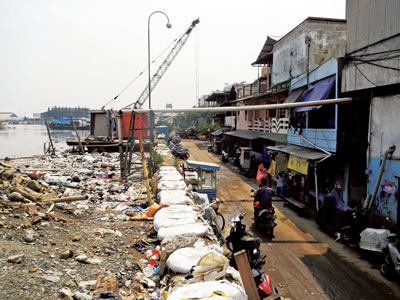
Some of the land adjacent to the sea is below sea level.
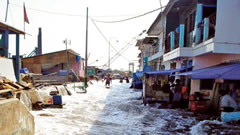
Source: National Capital Integrated Coastal Development (NCICD)
Identifying the areas in which the land was subsiding
A map of Jakarta created by analyzing images captured by ALOS and ALOS-2 (Advanced Land Observing Satellites). The green flags indicate areas where the land subsided 50 mm or more between 2007 and 2018, and the red and yellow flags indicate more severe subsidence.
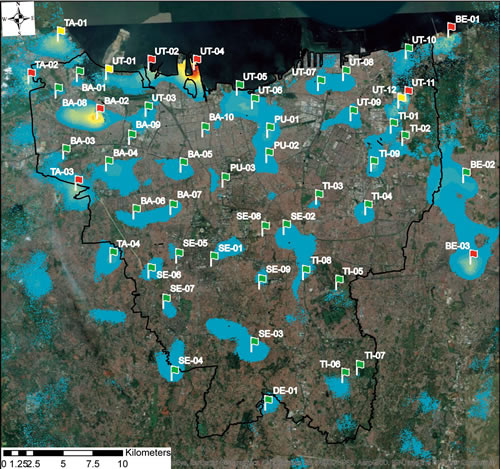
©JAXA/Project for Promoting Countermeasures against Land Subsidence in Jakarta
A comprehensive approach using satellite imagery
With over 10 million inhabitants, Jakarta, Indonesia's capital, is known as one of the great metropolises of Asia. While its population continues to grow, the city's northern districts have seen the ground subside as much as four meters since 1970, a problem caused in part by over-abstraction of the groundwater. Land subsidence is a problem throughout Jakarta, including in the city center. The increased risk of damage from flooding and storm surges, with a resulting halt in the flow of goods, has a significant effect on the city's population and its economy. It is feared that further climate change will induce heavy rains and storm surges that will inundate the city and surrounding districts, causing widespread damage.
"Land subsidence due to over-abstraction of the ground water was actually happening in Tokyo until the 1970s. We're utilizing this experience in the current project," says Takeshi Watanabe of Yachiyo Engineering, who leads JICA's project to combat the subsidence.
The first step was to identify the areas in which the land was subsiding. This was done by analyzing data captured by the Japan Aerospace Exploration Agency's (JAXA) Advanced Land Observing Satellites (ALOS and ALOS-2). Engineers then installed double-pipe observation wells in those areas, and set up systems to measure and record land subsidence and changes in groundwater level.
The project is currently at the stage where it plans to evaluate areas for flood and storm surge risk, create flood maps, and prepare proposals to stop the subsidence and protect the city from inundation. "All of this will contribute to climate change adaptation," says Watanabe.
A comprehensive approach is required: for example, legislation that regulates abstraction of the ground water needs to be passed, and alternative sources of water need to be secured. In order to achieve this, everyone concerned-the administration, businesses, industries, and the general population-needs to understand the present and future risks and accept the cost of dealing with them.
In addition to capacity development and support to develop a comprehensive action plan that takes climate change into consideration, the project will include programs aimed at raising public awareness.
A subsidence monitoring station
Three wells of different depth are installed at each location. The wells have two concentric pipes, and the inner pipe sinks when the ground subsides. The amount of soil shrinkage at various levels can be quantified by measuring the difference in amounts by which the pipes in the three wells subside.
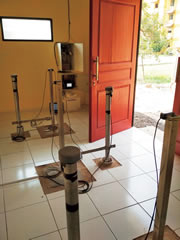
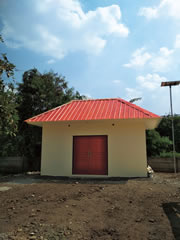
Takeshi Watanabe
Yachiyo Engineering Co., Ltd.
Takeshi Watanabe has worked with JICA for nearly 30 years in Indonesia and around the world. Currently he is the lead consultant supervising the present project. "It may take decades to stop the subsidence. We plan to help prepare an action plan tailored to Jakarta that incorporates Tokyo's experience so that the people of Indonesia can independently proceed with measures to stop the subsidence." Photo shows Watanabe (left) standing with Indonesian Minister of Public Works & Housing Basuki Hadimuljono.
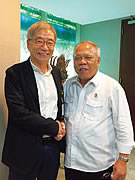




scroll